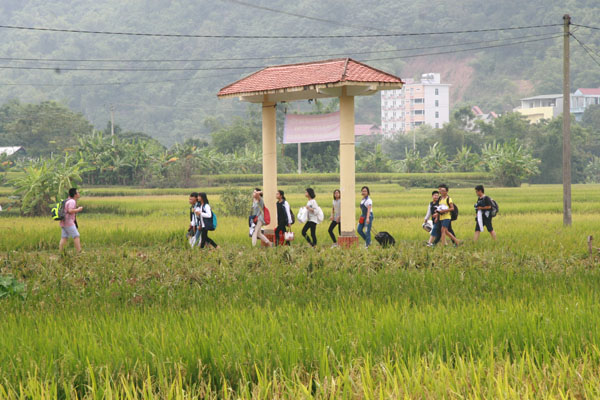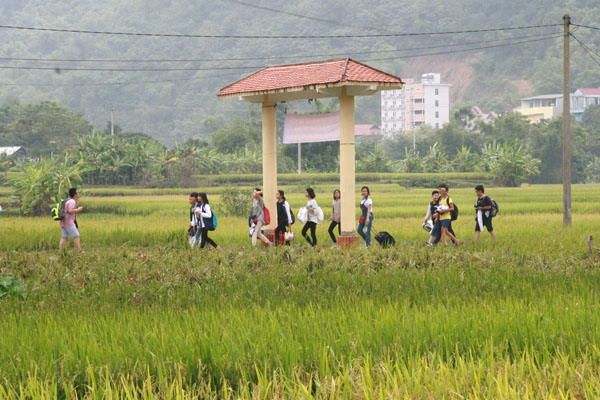
(HBO) –The bus runs from Hanoi along Road No. 6 north-westward to HoaBinh, the city of electricity and culture of different ethnic groups like Muong, Thai, Kinh, Dao, Mong and Tay. After passing Cunslope, the bus will reach the VuonhoanuiCoi (Coi Mount Flower Garden) cultural area in Cao Phong district, which is famous for its oranges and sugar-canes. Tourists should stop at the top of ThungKhePass to take a view of MaiChau Valley.

The
valley houses villages of ethnic groups in Mai Chauwith green rice and corn
fields under the mountain’s silhouette. There are stilt houses sitting at the
foot of the mountain and treesalong Xia Spring.
The valley is surrounded by high mountain ranges
which now appear, now disappear among clouds.
Arriving in Van and PomCoong villages in Mai
Chau town, Lac village in ChiengChau commune and Buoc village in XamKhoe
commune, visitors will be welcomed by local boys and girls in festive
clothes.
Local girls or owners of villages and families
will invite tourists to admire Thai people’s wide, clean and airy stilt houses
which are built from wood and bamboo. The houses have stairs at the two sides
and a vast shady space below. Surrounded by orchards, the houses boast a simple
but special beauty.
Visitors will be served with special local
dishes like Com lam muoivung (steamed sticky ricein bamboo tubes with sesame
and salt), Cha mianuong (roasted meat with sugarcane), barbecued or boiled pork
with Thai pepper, mountain chicken, multi-colour sticky rice, fish grilled in
banana leaves, wild bees, ant eggs, forest bamboo shoots and Mai Ha wine.
Vacationers can travel around villages,
mountains, forests and beautiful caves such as Nuoc, Khoai, Mo Luong, Chieu and
PiengKiem, and archeological sites like Long and KhauPhuc caves, along with
other national relic sites.
When it gets dark and cold, tourists are invited
to join a camp-fire organised at the courtyard of the cultural house and enjoy
traditional art performances. Local girls, boys and children amorously play
pan-pipes, gourd lutes, double flutes and gongs. Holiday-makers also have a
chance to enjoy traditional dances like sap, kengloong, nhumhua, khan (scarf),
quat(fan), kepbooc, ong (pipe) and ton coog.
Tours are available for those who are interested
in exploring the life of Mong people and their traditional culture in Pa Co and
Hang Kia communes, which are located
1,288 m above the sea level, with a pitch of
30-35 degrees.
Roofed with woodor thatch, Mong people’s houses
have gardens surrounded by stone walls. In the spring, Mong villages will be
covered by apricot, peach, plum and Ban flowers.
Locals exchange greetings on the way to the
market with dances and sounds of pan-pines and lip lutes.
The crowded and special village fair offers
visitors wine and "thang co” (horse meat soup). Old people come to the market
regularly to meet their old friends. It is a really an interesting place for
visitors to experience the local life.
Bui Chi
Thanh
In the first 9 months of 2024, Hoa Binh province continues to implement the expanded tourism development cooperation program plan of 8 Northwest provinces with Ho Chi Minh City; deploying digital transformation content in tourism and developing a smart tourism province. Hoa Binh province received about 3.6 million views, an increase of 7.9% over the same period. In which, international visitors are about 380 visitors, domestic visitors are estimated at 3 million 220 visitors.
Spanning thousands of hectares and winding gracefully along mountain slopes, hillsides, and riverbanks, the terraced rice fields of Lac Son District present a stunning and captivating beauty. This region, renowned for its remarkable terraced landscapes, is also the centre of Hoa Binh Culture known for numerous archaeological sites.
The life of Mong people in Hang Kia and Pa Co communes of Mai Chau district has improved much thanks to tourism development.
The man-made Hoa Binh Lake, with a water surface area of approximately 9,000 hectares and a capacity of 9.45 billion cubic meters, stretches over 200 kilometers from Hoa Binh to Son La provinces. With the goal of developing into a national tourism area, the Hoa Binh Lake tourism area is expected to not only become the largest tourism centre in the province but also one of the 12 key tourist destinations in the northern midland and mountainous region of Vietnam.
Da Bia hamlet, now Duc Phong, in Tien Phong commune, Da Bac district, was once almost isolated from the outside as the only way to the hamlet was to get a boat ride across the Hoa Binh reservoir. However, as its tourism potential has been unleashed, the hamlet has established itself as one of the most attractive destinations on the tourism map. It has even received the ASEAN Community-Based Tourism Awards in 2019.
In the first 9 months of 2024, Mai Chau district, Hoa Binh province welcomed over 684 thousand visitors to visit and relax. In which, over 516 thousand domestic visitors and more than 168 thousand international visitors. Total revenue from tourism is estimated at over 821 billion VND.


